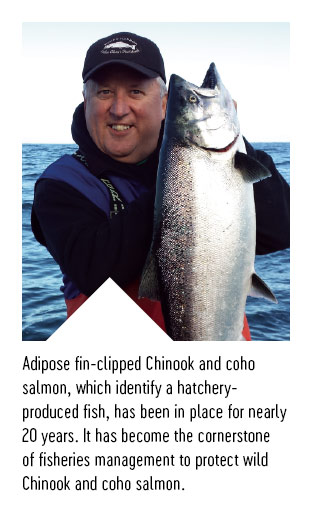A couple of columns ago, I received a reply from a reader who asked several questions about the program (federal, state, and tribal) requiring all hatchery Chinook and coho salmon to be adipose fin clipped prior to their release. The program, for those of us who have been wallowing in salmon management for years, is designed to help salmon anglers identify a wild fish (unmarked with natural adipose fin) versus a hatchery-produced fish (missing fin). Catch my drift?
To my knowledge, this activity, required by federal law, has not been examined publicly since its implementation years ago. Although this writing does not represent any form of investigative review, I thought the writer’s question about oversight, partially clipped adipose fins, and related questions is worthy of discussion. Ready to go for a ride?
One of the debates I hear over and over on the water and off is if the tribes are marking all of their hatchery fish. Further, is a fish that shows some deformity in the adipose fin actually a hatchery fish, or simply a mishap of the clipping process?
I began my attempt to learn more by discussing these issues with the folks at Northwest Marine Technology, who have led the science of fin clipping adipose fins for decades here in Olympia. They introduced me to a research paper, authored by Daniel Thompson and H. Lee Blankenship, produced 20 years ago and printed in the North American Journal of Fisheries Management. Sounds pretty techy, huh?
 The paper is called “Regeneration of adipose fins given complete and incomplete clips.” Once I started to read this document, I paused for a moment in order to put on my white lab coat, helping me to comprehend the science.
The paper is called “Regeneration of adipose fins given complete and incomplete clips.” Once I started to read this document, I paused for a moment in order to put on my white lab coat, helping me to comprehend the science.
In summary, sparing you further MC2 divided by XYZ math, the report suggests that there is significant regeneration of the adipose fin if the removal is done by hand versus the new computer-driven machine that accomplishes the clipping. The report further suggested that one out of four clips regenerate again if a technician is attempting the task and the clip is not 100% successful. A technician can remove between 5,000 – 8,000 adipose fins per day.
But today, with the advanced technology of automated machines designed to clip adipose fins, one machine can clip between 60,000 to 100,000 fins per day. The Washington Department of Fish and Wildlife clips around 90 million adipose fins every spring at salmon hatcheries throughout the state. Toss in the feds and tribes, and the number is closer to over 150 million clipped adipose fins. It is also important to recognize that the automated machines are nearly perfect in complete adipose fin clips (1 in 400 partial clip), much better than clipping by hand.
Once this effort began nearly two decades ago, there were considerable rumors that some tribes were reluctant to participate in the new requirement. Today, that is not the case. The tribes are clipping their hatchery Chinook and coho and using the new automated machines, producing a near perfect product. Case closed and end of debate.
In summary, it is important when attempting to land a Chinook or coho salmon in Washington that a careful examination of the adipose fin or healed scar from a removed adipose fin is done. Regenerated adipose fins are not uncommon and with as much certainty as possible, deformed regenerated adipose fins are clearly a hatchery-produced fish. However, if the adipose fin is anatomically perfect, the chances are extremely possible that it is a wild fish. And, if there is any thought to remove the adipose fin on the water while in an area where all wild or adipose-bearing fish must be returned, enforcement troops from the Department of Fish and Wildlife will be eager to meet you.
February Saltwater Options
For this angler, February is a great month to go salmon fishing. The banks in the eastern Strait of Juan de Fuca are heating up along with Seiku to Port Angeles for great winter blackmouth fishing options. We are typically also coming out of the tough days that winter has delivered and I’m pawing the dirt to get on the water.
Speaking of tough days on the water, the Olympic Peninsula Salmon Derby, the longest standing salmon derby in Washington (called by some as the Iron Man Salmon Derby), is just around the corner from February 17-19. The biggest winter blackmouth catch entered in this three-day tournament will dish out $10,000. Need some quick cash, Vern? You can learn more by heading to nwsalmonderbyseries.com. See you on the water!